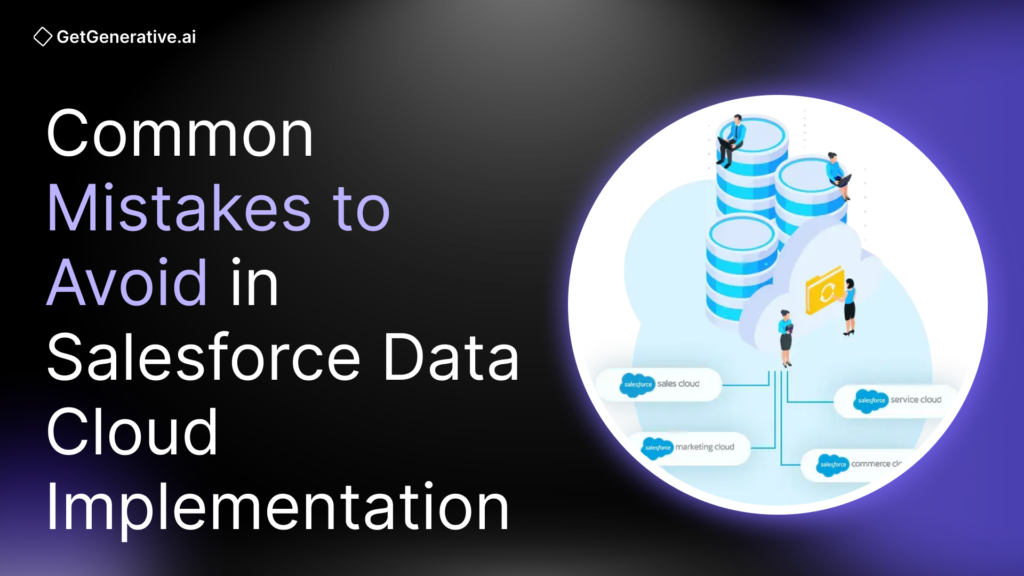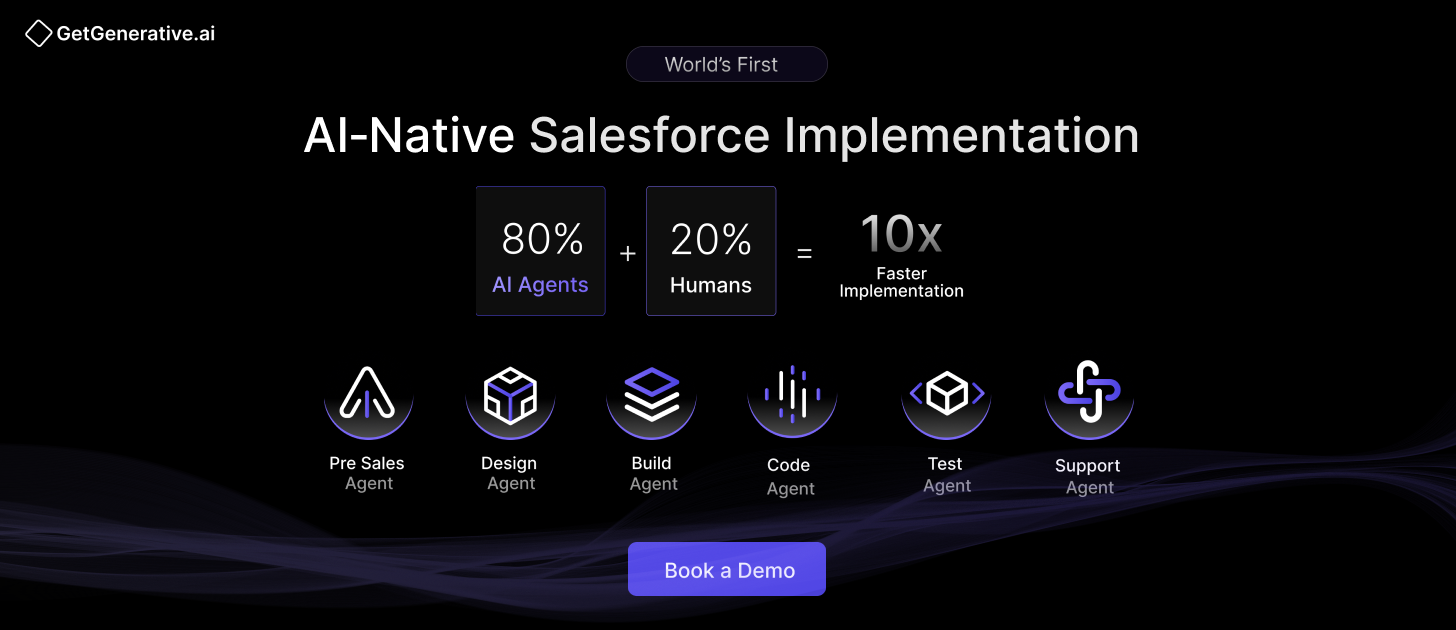Common Mistakes to Avoid in Salesforce Data Cloud Implementation
Implementing Salesforce Data Cloud can transform your organization, offering powerful tools to centralize, analyze, and act on customer data. However, a successful implementation is not just about the technology—it’s about avoiding common pitfalls that can derail your efforts. From poor planning to neglecting user training, these mistakes can cost time, resources, and business growth.
Let’s dive into the most common errors and how to avoid them.
Define Clear Objectives and Use Cases
1. Lack of Measurable Goals
Too many Data Cloud implementations begin with vague ambitions like “unify our customer view” or “enable personalization”—without defining what success looks like. This leads to scope creep, misaligned expectations, and poor ROI.
Best Practice:
Set quantifiable goals from the start. For example:
Reduce churn by 5% in Q3
Increase cross-sell conversion rate by 10%
Merge loyalty program data from three systems into one profile view
2. Misaligned or Underspecified Use Cases
Even with clear objectives, skipping over detailed use case planning is a critical error. Salesforce Data Cloud’s value comes from the use cases it powers, such as dynamic segmentation, predictive scoring, and cross-channel journey orchestration.
Jack Searle of Capgemini explains:
“Data Cloud projects are mostly discussion and planning. Much of it is spent on identifying use cases… it can be harder to do without a full understanding of your Salesforce setup, usage, and business processes.”
Recommendation: Run discovery workshops before implementation. Prioritize 2–3 high-impact use cases to launch with (e.g., abandoned cart recovery, VIP customer targeting). Use these early wins to build momentum for broader rollouts.
Conduct Thorough Planning and Resource Estimation
3. Underestimating Scope and Complexity
Salesforce Data Cloud is not a “plug-and-play” solution. It requires deep planning across data modeling, identity resolution, ingestion pipelines, and governance.
Common Oversight:
Teams often underestimate the effort required for data mapping, profiling, integration testing, security configuration, and training. Projects spiral when unexpected data issues surface midstream.
Solution:
Adopt an Agile, phased approach. Use sprints to test and validate assumptions before scaling. Build in contingency buffers for each phase—especially data onboarding and transformation logic.
4. Inflexible or Misaligned Planning
Over-planning can be just as dangerous as under-planning. Salesforce releases frequent platform updates—so rigid implementation plans can quickly become obsolete.
Advice from the Field:
“Plans are nothing; planning is everything.” – Dwight D. Eisenhower
This adage is echoed by many Salesforce consultants. Define your roadmap, but revisit assumptions continuously.
5. Misaligned Teams and Ownership
Projects fail when leadership treats Data Cloud as “just another IT initiative.” You need executive sponsorship and a cross-functional team that spans business, data, IT, and compliance.
Checklist for Project Readiness:
| Role | Responsibility |
| Executive Sponsor | Budget and strategic alignment |
| Data Architect | Data model design and identity rules |
| Integration Engineer | Source connectors and sync testing |
| Data Steward | Data quality and governance |
| Business Analyst | Use case definition and KPIs |
| Admin/Trainer | User setup, training, and adoption |
Prioritize Data Quality and Governance
6. Poor Data Profiling
Data Cloud thrives on clean, well-understood data. One of the most damaging mistakes is to ingest massive volumes without first understanding what’s in them.
7. Lack of Governance and Standards
Without governance, your environment will become chaotic—multiple versions of the same field, undocumented transformations, and inconsistent naming conventions.
Real-World Example:
If one data source has a field labeled Account_Segment__c and another has Target_Market__c, but both represent the same concept, users will get confused unless a data dictionary or crosswalk table defines the canonical version.
8. Skipping Basic Data Hygiene
Don’t demo your unified profile with fake emails like test@test.com or placeholder names like “John Doe.” Bad data kills credibility instantly.
Action Steps:
Filter or clean test and junk records
Backfill or discard low-quality fields
Use Data Cloud’s transformation functions to standardize input formats (dates, phone numbers, etc.)
Also Read – Salesforce Data Cloud Features
Plan Architecture and Integrations Carefully
9. Neglecting System Integrations
Data Cloud’s strength lies in unifying all customer data across systems—but many implementations isolate it. Assuming Data Cloud will “just see” your existing data sources is a costly mistake.
Common Oversight:
Teams often connect only Salesforce clouds (Sales, Marketing, Service) and leave out ERP, POS, or third-party systems like Snowflake, Databricks, or legacy CRMs.
Actionable Advice:
Inventory all data sources before implementation.
Use standard connectors or middleware like MuleSoft where needed.
Select integration types based on business needs: streaming for real-time actions, batch for analytics.
10. Data Trapping and Silos
If you’re syncing Data Cloud segments back into Salesforce manually via CSVs, you’ve simply created another silo.
Best Practice:
Use native zero-copy integrations and APIs to surface unified profiles back into Marketing Cloud, Sales Cloud, and Service Cloud.
11. Ignoring Scalability
Salesforce Data Cloud can handle massive volumes—but only if your pipelines and architecture are scalable.
Design for Scale:
Use modular ingestion pipelines
Implement retry logic for failed jobs
Monitor ingestion latency and backlog
Consider Salesforce Hyperforce for global scaling
Design data models to accommodate new fields/sources without full reengineering
Example:
During peak retail season, brands often see data spikes. If your data pipeline can’t scale, segmentation and activation will lag, undercutting personalization efforts.
Manage Costs and Resources Wisely
12. Misunderstanding the Credit Model
Unlike license-based models, Salesforce Data Cloud uses consumption-based pricing (credits). Each ingestion, transformation, or activation burns credits.
Common Pitfall:
Bulk-loading all historical data “just in case” leads to credit overuse and budget overruns.
Recommendations:
Load only essential historical data in phased tiers
Set alerts for credit usage in the Salesforce Digital Wallet
Audit pipelines regularly—pause jobs that aren’t adding value
13. Resource Under-allocation
A successful implementation needs more than a Salesforce admin. It requires architects, data engineers, analysts, and change managers.
Minimum Team Composition:
| Role | Must-Have? |
| Salesforce Admin | ✅ |
| Data Engineer | ✅ |
| Integration Lead | ✅ |
| Architect (DMO/identity) | ✅ |
| Business Analyst | ✅ |
| Compliance Officer | Optional, but recommended |
| Trainer / Adoption Champion | ✅ |
Avoid Over-Engineering
14. Complexity Kills Adoption
Some companies try to build overly sophisticated segmentation logic, dynamic models, and nested hierarchies—only to confuse the end users.
Best Practice:
Start with 3–5 simple segments tied to known business goals. Use native tools like Einstein Segment Recipes and Flow Automations to keep logic accessible.
15. Customization Overload
Balance is key. While avoiding complexity, don’t settle for default settings if your business needs require custom data models, connectors, or logic.
Tailor Thoughtfully:
Extend the schema only for fields critical to KPIs
Use crosswalk tables for source harmonization
Avoid customizations that hinder future Salesforce updates
Also Read – Salesforce Data Cloud Implementation Guide 2025
Enforce Security and Compliance
16. Overlooking Regulatory Compliance
Data Cloud often holds PII, purchase history, case data, and other sensitive records.
Laws to Consider:
GDPR (EU)
CCPA (California)
HIPAA (Healthcare)
Best Practices:
Perform a Privacy Impact Assessment (PIA)
Use Salesforce Shield for encryption and monitoring
Apply row-level security and field-level access controls
17. Weak Role-Based Access Controls
Not every user should see or edit every field or segment. Failing to restrict permissions increases security risk.
Recommendations:
Use Permission Sets and Sharing Rules strategically
Audit access logs regularly
Train admins on security best practices
Invest in User Adoption and Change Management
18. Late Stakeholder Engagement
Involving end-users late in the process leads to frustration and rejection.
Actionable Advice:
Demo features to marketing/sales teams early
Co-develop segments with business users
Identify “power users” in each department as champions
19. Inadequate Training
Data Cloud has a steep learning curve. If users don’t understand it, they won’t use it.
Role-Based Training Tips:
Marketers: Focus on segment building and activations
Analysts: Focus on DMOs, DLOs, and query paths
Admins: Focus on governance, integrations, and credit usage
Build for Continuous Governance and Optimization
20. “Set It and Forget It” Syndrome
Many organizations treat go-live as the finish line. In reality, it’s the starting point.
Post-Implementation Musts:
Assign ongoing ownership (internal or managed partner)
Schedule monthly system health checks
Set up alerts for ingestion failures, segment failures, or credit spikes
21. Lack of Iteration
Data Cloud needs to evolve with your business.
Suggestions:
Revisit your data model every 6–12 months
Retire unused segments
Add new sources as campaigns expand
Use KPIs to assess impact and reprioritize data credits accordingly
Conclusion
Salesforce Data Cloud’s success lies in the execution. Avoid common pitfalls like poor planning, data mismanagement, and insufficient training. Instead, focus on clear objectives, robust security, and intentional data use. By adhering to these proven strategies, your organization can maximize the benefits of Salesforce Data Cloud.
At GetGenerative.ai, we’ve reimagined Salesforce implementation—built from the ground up with AI at the core. This isn’t legacy delivery with AI added on. It’s a faster, smarter, AI-native approach powered by our proprietary platform.
👉 Explore our Salesforce AI consulting services
FAQs
1. What is the main challenge in Salesforce Data Cloud implementation?
The most common challenge is the lack of clear objectives. Without defined goals, it’s difficult to align teams and measure success.
2. How can I improve data quality before implementation?
Start with data cleansing, validation, and audits. Use Salesforce’s built-in data management tools to maintain data consistency and accuracy throughout the implementation process.
3. Why is user training critical for Data Cloud?
Empowering your team with proper training enhances their ability to use the platform effectively, increasing adoption rates and productivity.
4. Can Salesforce Data Cloud scale with my business?
Yes! Salesforce Data Cloud is designed for scalability, provided you plan for growth during implementation.
5. How to Measure the Success of Your Data Cloud Implementation?
Define KPIs aligned with your goals, establish baseline metrics, and track progress over time using data-driven insights.




